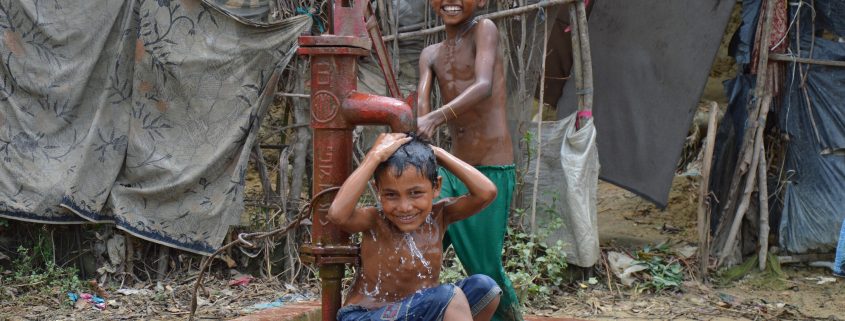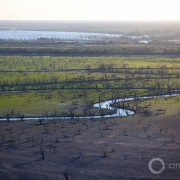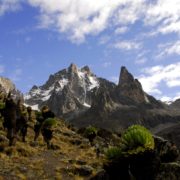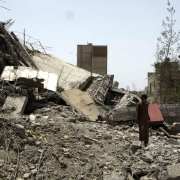HotSpots H2O, February 7: Spotlight on the Rohingya Refugee Crisis
The Rundown
Since August 2017, nearly 700,000 Rohingya Muslims have fled persecution in Myanmar following widespread, brutal attacks against the Rohingya community. Most journeyed to Cox’s Bazar, a district in neighboring Bangladesh, where they joined thousands of other Rohingya who escaped during earlier waves of persecution. Now, nearly 1 million Rohingya are packed into teeming, makeshift refugee camps. Not surprisingly, access to water and sanitation is woefully inadequate, and the situation could soon be worsened as the region’s annual cyclone and monsoon seasons begin.
“As we get closer to the cyclone and monsoon seasons, what is already a dire humanitarian situation risks becoming a catastrophe.” –Oliver White, senior policy adviser for forced migration at UNICEF Australia, in reference to the overflowing, unsanitary Rohingya camps along the border of Bangladesh. Heavy rains and severe storms will increase the likelihood of flooding, landslides, and waterborne diseases, making the refugees’ living conditions even more grim.
By The Numbers
900,000 Number of Rohingya living in refugee camps throughout Cox’s Bazar, Bangladesh, according to recent estimates. The entire population is reliant on international aid to provide basic amenities.
44,493 Number of emergency latrines built by the Bangladesh military. Many makeshift toilets have also been dug throughout the camps, often side-by-side with wells.
276,950 Estimated number of refugees who have access to clean water through UNICEF-supported tube wells and treated surface water.
17 million liters Amount of clean water that would be needed per day to meet the needs of the entire Rohingya refugee population.
50 percent Proportion of water points in the main Rohingya camps that are at risk from flooding, a growing concern as monsoon season approaches.
25 percent Proportion of Rohingya refugee shelters destroyed last May by Cyclone Mora, when the refugee camps were a fraction of the size they are now. Wells, toilets, and roads were also damaged.
Science, Studies, And Reports
Over half of Rohingya refugees are children, including 58 percent of new arrivals. A high number of pregnant and lactating women are also fleeing to Bangladesh. Small children are especially susceptible to the deadly diseases circulating throughout the Rohingya camps, including acute watery diarrhea and diphtheria. The UN Children’s Fund publishes a weekly Humanitarian Situation Report, detailing developments in nutrition, health, WASH, and disease prevention.
On The Radar
The Rohingya refugees are bracing for the onset of severe weather, which will likely begin in March. Tropical cyclones often strike Bangladesh in two season, March through July and September through December. In addition, monsoon rains typically begin in June. The storms pose a serious risk to shelters, water systems, latrines, and other infrastructure. Damaged infrastructure, along with pools of stagnant water, also exacerbate the risk of diseases such as diarrhea, cholera, and malaria.
In recent months, Bangladesh and Myanmar have discussed the possibility of repatriating the Rohingya. At the end of January, Myanmar agreed to accept 1,500 Rohingya each week, but Bangladesh then halted the process due to delays in verifying the list of returnees. There is also concern that the repatriation, which is supposed to be voluntary, would become forced, especially as evidence of further atrocities is uncovered in Myanmar. Bangladesh has not set a new date for repatriation to begin.
Resources and Further Reading
AP Investigation Details Shocking Massacre, Mass Graves of Myanmar Rohingya (NPR)
Bangladesh: Humanitarian Situation report No.21 (Rohingya influx) 4 February 2018 (Relief Web)
Bangladesh postpones plan to send Rohingya refugees back to Myanmar (CBC)
Half a million Rohingya refugee children at risk in overcrowded camps in Bangladesh with cyclone and monsoon season on horizon (UNICEF)
Myanmar Rohingya: What you need to know about the crisis (BBC)
Rohingya crisis: Bangladesh and Myanmar agree repatriation timeframe (BBC)
Rohingya refugee children at risk from monsoon season ‘catastrophe’ (The Guardian)
Statement by UN High Commissioner for Human Rights Zeid Ra’ad Al Hussein (OHCHR)
Kayla Ritter is a recent graduate of Michigan State University, where she studied International Relations and Teaching English to Speakers of Other Languages. She is currently based in Manton, Michigan. Kayla enjoys running, writing, and traveling. Contact Kayla Ritter












